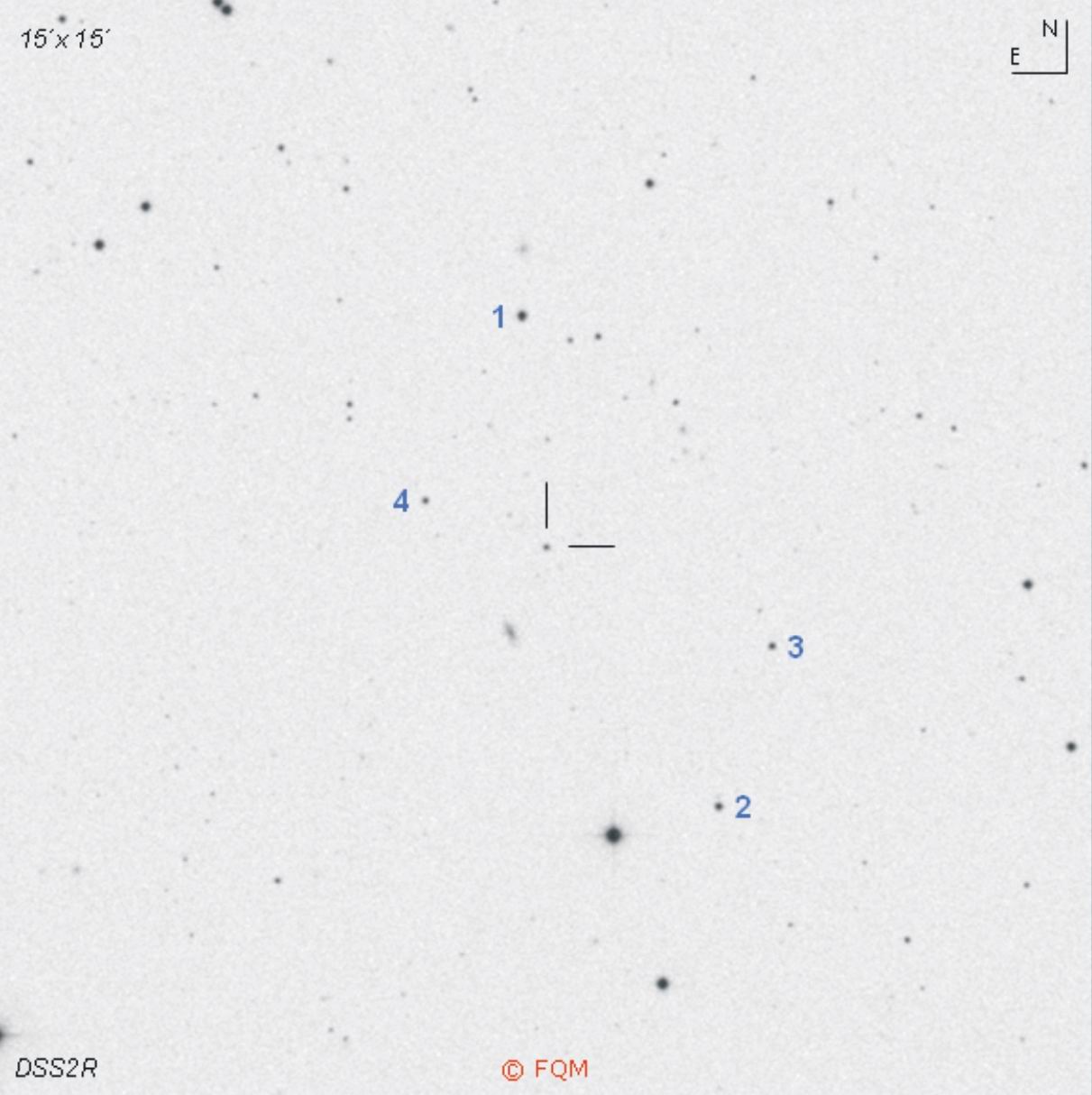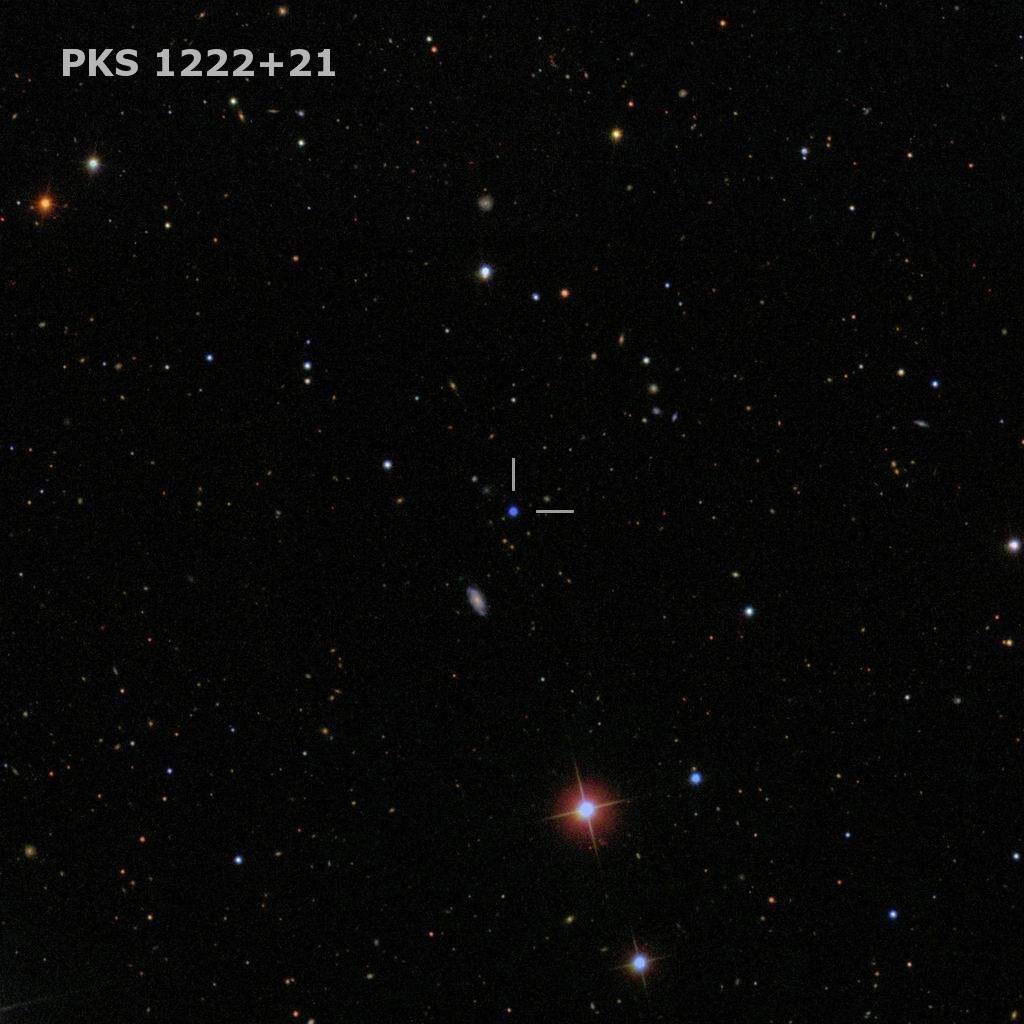
| Frankfurt Quasar Monitoring |
| PKS 1222+21 |
| Cross-Identifications | PG 1222+216, 4C 21.35, ON 238, LEDA 2819691 MG2 J122455+2122, 87GB 122224.2+213918 7C 1222+2139, S3 1222+21, TXS 1222+216 SWIFT J1224.9+2118, 1FGL J1224.7+2121 2MASSi J1224544+212246, GRO J1222+22 SDSS J122454.46+212246.3, 1222+216 RX J1224.9+2122, 2EG J1224+2155 |
| Equat. coordinates | RA 12 24 54.5 DE +21 22 46 (J2000) |
| Constellation | Coma Berenices |
| Type | QSO |
| Redshift | z=0.435 (1) / z=0.432 (2) |
| Distance (2) (3) | 1612 Mpc |
| Total mag range (mv) (4) (5) | 14.0 - 17.5 |
| Catalog Magnitude (1) | 17.50 |
| Absolute Magnitude (1) | -24.6 MB |
| Light Travel-Time (2) | 4.395 × 109 yrs |

Comparison stars
| star | B | V | Rc |
| 1 | 14.99 (0.03) |
14.19 (0.04) |
13.84 (0.03) |
| 2 | 15.45 (0.04) |
14.86 (0.03) |
14.56 (0.03) |
| 3 | ---- |
15.66 (0.03) |
15.26 (0.04) |
| 4 | 17.17 (0.05) |
16.24 (0.03) |
15.83 (0.03) |


| PKS 1222+21 is a violently variable Quasar in Coma Berenices, located just south of the Coma Cluster Mel 111. The designation PKS 1222+21 refers to the Parkes Radio Survey (PKS), where this object was cataloged as a radio source in 1966. PKS 1222+21 was discovered as a radio source by the 4th Cambridge Radio Survey (4C) in the mid 1960s, followed by both the Parkes Radio Survey (PKS) and the Ohio Radio Survey (ON) soon after. That is why PKS 1222+21 is often termed ON 238. Since then, this Flat-Spectrum Radio Source has been catalogued by several other radio surveys. In addition, a radio jet was discovered, which points to the north and has an angular extent of about 17 arcsec. In 1966, the radio source was first identified with a faint stellar object of 17.5 mag. Spectroscopic investigations revealed a redshift of z=0.433, which was refined to z=0.435 in 1967. This new stellar object was immediately classified as a quasar. In the early 1980s, PKS 1222+21 was catalogued as a UV-bright, blue stellar object by the Palomar-Green Bright Quasar Survey (PG). Besides the UV and optical, quasar PKS 1222+21 has also been known as a variable X-ray and gamma source since the 1990s. The central powerhouse of this quasar is a supermassive black hole with an estimatet mass of 6×108 solar masses. It shall be stressed that the identification of PKS 1222+21 with PGC 40438 by the NASA/IPAC Extragalactic Database is incorrect. In fact, PGC 40438 is the small galaxy (16.9 mB) only 1.2 arcmin SSE of the quasar (PGC 40438 = 2MASX J12245651+2121362). ____________ Quasar PKS 1222+21 is a violently variable object, ranging between 14.0 mag and 17.5 mag in the optical. On average, the brightness ranges between 15 mag and 16 mag, so visual observers need at least a telescope of 12 inch or 14 inch of aperture or larger to detect this stellar object in the eyepiece. CCD observers, as well as visual observers, shall use the comparison stars given above. In June 2010, an outburst of gamma and X-ray emissions was detected (ATel #2686, #2687), accompanied by an optical flare reaching v=14.21 at maximum (ATel #2708). The latest optical outburst was detected independently by the St. Petersburg University and the Frankfurt Quasar Monitoring project on Feb. 24/25, 2014, when PKS 1222+21 reached a maximum of R=13.80 (ATel #5921) and v=14.22 (VSNET alert 16953), respectively. The outburst reached its maximum on March 2, 2014 with a peak brightness of v=13.99, again detected by the Frankfurt Quasar Monitoring project (VSNET alert 16978). ____________
Quasar PKS 1222+21 is located in the western part of Coma Berenices, a
few degrees south of Coma Cluster Mel 111. This large open cluster is
only about 280 light-years away, so it is an easy catch for
both the naked eye and binoculars. PKS 1222+21 is surrounded by a large number of bright galaxies. The quasar lies right between the Coma I galaxy group (about 5° to the NE, with its deep sky showpieces like NGC 4559, NGC 4494 and NGC 4565), and the rich Virgo galaxy cluster, with its centre only 8° south. Bright member M85 is located only 3° south of the quasar position. A more exotic deep sky object is 10-mag globular NGC 4147, located 4.4° SW, at a distance of about 60.000 light-years. Its position close to the galactic pole is quite unusual. Recent investigations point to the fact that NGC 4147 might not be a globular of the Milky Way, but probably is a member of the Sagittarius Dwarf Elliptical Galaxy (SagDEG=Sgr dSph), as it lies inside the Sagittarius Tidal Stream (see: Law et al. 2010). Another bright extragalactic variable object can be found 7.7° to the south-west of quasar 1222+216. Quasar PG 1211+143 is a bright and slightly variable 14-mag object at a distance of about 1.0×109 light-years. By pointing the telescope 7° to the north of quasar 1222+216 we reach the position of W Com, a violently variable BL Lac object, located at a distance of about 1.3×109 light-years. |
| Bolton, J.G., Shimmins, A.J., Merkelijn, J., 1968, AuJPh, 21, 81; Identification of Radio Sources Between Declination +27° and -30°. Burbidge, E.M., Kinman, T.D., 1966, ApJ, 145, 654; Redshifts of Fourteen Quasi-Stellar Radio Sources. Dixon, R.S., Kraus, J.D., 1968, AJ, 73, 381; A High-Sensitivity 1415 MHz Survey at North Declination between 19° and 37°. Farina, E.P., et al., 2012, MNRAS, 424, 393; The optical spectrum of PKS 1222+216 and its black hole mass. Hooimeyer, J.R.A., Schilizzi, R.T., et al., 1992, A&A, 261, 5; Two new candidate superluminal quasars: 4C 28.45 and 4C 21.35. Jorstad, S.G., Marscher, A.P., et al., 2001, ApJS, 134, 181; Multiepoch Very Long Baseline Array Observations of EGRET-detected Quasars and BL Lacertae Objects: Superluminal Motion of Gamma-Ray Bright Blazars. Law, D.R., Majewski, S.R., 2010, ApJ, 718, 1128L; Assessing the Milky Way Satellites associated with the Sagittarius Dwarf Spheroidal Galaxy. Lynds, C.R., 1967, ApJ, 147, 837L; New Spectroscopic Observations of Twenty Quasi-Stellar Sources. Olsen, E.T., 1970, AJ, 75, 764; Optical identification of radio source selected from the 4C catalogue. Pilkington, J.D.H., Scott, P.F., 1965, MmRAS, 69, 183; A Survey of Radio Sources between Declinations 20° and 40°. Sandage, A., 1972, ApJ, 178, 25; The Redshift-Distance Relation. III. Photometry and the Hubble Diagram for Radio Sources and the Possible Turn-On Time for QSOs. Véron-Cetty, M.-P., Véron, P. 2001, A&A 374, 92; A Catalogue of Quasars and Active Nuclei: 10th edition. Véron-Cetty, M.-P., Véron, P. 2003, A&A 412, 399; A Catalogue of Quasars and Active Nuclei: 11th edition. Véron-Cetty, M.-P., Véron, P. 2006, A&A 455, 776; A Catalogue of Quasars and Active Nuclei: 12th edition. Véron-Cetty, M.-P., Véron, P. 2010, A&A 518, 10; A Catalogue of Quasars and Active Nuclei: 13th edition. |
| Links: Landessternwarte Heidelberg Sloan Digital Sky Survey [ATel #2686] AGILE detection of a gamma-ray flare from the blazar 4C+21.35 (PKS 1222+21) [ATel #2687] Fermi LAT detection of a very intense GeV flare from 4C+21.35 (PKS 1222+21) [ATel #2693] Optical polarimetric observations of 4C+21.35 (PKS 1222+21) during the ... [ATel #5921] Quasar PKS 1222+21 in outburst [VSNET alert 16953] Quasar PKS 1222+21 in outburst [VSNET alert 16978] Quasar PKS 1222+21 outburst continue |
| home |